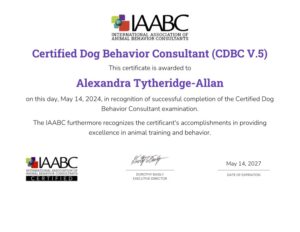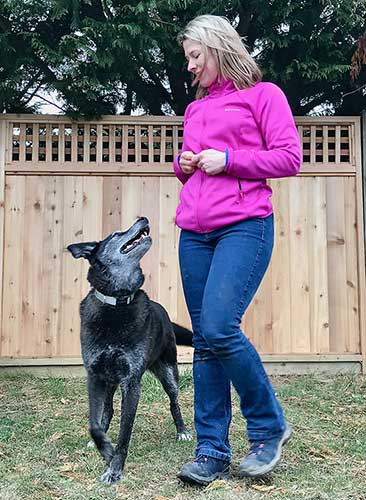The internet and social media offers no shortage of information on dog training and behavior modification. But what’s the difference? Read on to learn more.
What is a “dog behavior consultant”?

Als Allan is the only Certified Dog Behavior Consultant in Rutland County
In May I became accredited as a Certified Dog Behavior Consultant by the International Association of Animal Behavior Consultants (IAABC). I am the only professional dog trainer in Rutland County with this credential and am extremely proud of the achievement. The credentialing process is not for the faint-hearted – it requires many hours working in and studying behavior consulting, professional and personal references, successful completion of an extensive exam that assesses working knowledge of learning theory, counterconditioning, desensitization, training and husbandry, with additional in-depth knowledge of assessment skills and application of species-specific knowledge, and in addition the submission of three detailed case studies demonstrating the practical application of knowledge and skills. Experienced behavior consultants scored my exam against an objective rubric. The IAABC itself meanwhile is a neutral third-party credentialing body – a higher standard of evaluation than a school, from which you ultimately purchase a diploma.
Dog training versus behavior modification
Dog training is an unregulated industry. Anyone can take one of the many “dog training” courses and claim themselves an expert. But things get even murkier when it comes to behavior modification (BMod) in dogs. Most dog trainers will offer some form of BMod and many unwanted behaviors are truly the result of lack of training so it makes sense that someone who can train dogs can solve such problems. There is a wide gap between the way two trainers will address the same “behavior problem”. If we take unwanted jumping as the example, a modern, rewards-based trainer will start solving the issue by preventing rehearsal and teaching the dog a more acceptable but incompatible behavior – the dog can’t jump up on guests if he is patiently sitting next to his handler. A corrections-based or “balanced” trainer is more likely to suggest doing something that the dog won’t like so they won’t repeat the behavior – typical examples would include yanking on a leash or putting a knee in the dog’s chest. From a purely technical point of view, if the dog is no longer jumping up, then either approach can be effective. The “downside” to the reward-based approach is that your dog gets something it enjoys – be it food, play or affection. The very-real downside to the corrections-based approach is that the dog gets hurt – physically or emotionally, and is likely learning to distrust the handler. This often leads to more unwanted behaviors.

These tools are unnecessary for training your “best friend”.
But dogs will also display many other behaviors which don’t fit quite so neatly into the “untrained” category. Many behavior issues have a medical component – they won’t resolve until the underlying medical issue has been addressed. Emotions drive many unwanted behaviors. Again, veterinary intervention may well be needed but you’re also now looking at changing an emotional state. If a dog is anxious, you don’t change that mental state through teaching the dog to sit or by correcting the dog when it jumps up. The dog might not repeat the same unwanted behavior of jumping up, but you’ve done nothing to address the underlying issue – anxiety. Just like with people, it’s not healthy for a dog to have to bottle up its feelings. Real long-lasting change comes when you resolve the underlying problem. Humane behavior modification can be time consuming. It is not a quick fix. But it is both effective and the fairest way to treat your best friend.
For many dogs, fear is at the root of an unwanted behavior. Signs of fear include dogs who try to run away (flight), some might cower/shut down (freeze), others consider a good offense is their best defense (fight). You also come across the ones who become more goofy (fawn). The latter two categories most frequently cause problems with trainers. The dog is scared as opposed to being dominant or stubborn. You won’t resolve that issue through training. Of course there are many dogs who aren’t (for example) barking or lunging because they are scared – they are giving you clear warnings to move away. It is necessary to train a working line German Shepherd, bred for protection, that he’s not always on duty. But the same dog, ineffectively trained with correction-based methods, needs to learn how to trust people. And that’s when someone who understands the difference between training and behavior modification comes in. You can’t train fear out of a dog. You can desensitize and counter-condition it to fear-inducing stimuli. Sadly, when trainers try to “correct” a fearful dog all they do is punish the dog for communicating that they’re uncomfortable. I much prefer to know when a dog is uncomfortable than not having that information. Clear warnings typically precede dog bites. This is not the case when a dog has been “corrected” for growling or barking.
What about “behaviorist”?

Lunging dogs are often reacting out of fear.
But it’s important to note that a Certified Dog Behavior Consultant is not a “behaviorist” – that title is reserved for a very few even more highly educated people. They are: 1) the Veterinary Behaviorist (DACVB). These veterinarians have met rigorous qualifications set by the American College of Veterinary Behavior. 2) The Certified Applied Animal Behaviorist (CAAB). Such individuals have met the qualifications set by the Animal Behavior Society and typically have a PhD or Doctorate and advanced studies in animal behavior. 3) Associate Certified Applied Animal Behaviorist (ACAAB) – these individuals have a Master’s degree in a biological or behavioral science with an emphasis in animal behavior plus extensive practical experience. If your dog trainer calls themselves a “behaviorist” then run, run away fast.
The takeaway? Caveat Emptor – buyer beware. At Mountainside Mutts we are passionate about sharing our commitment to modern, humane, rewards-based training and behavior modification. Effective training takes time and consistency. Quick-fixes are more about reinforcement for the person holding the leash. Behavior modification meanwhile will involve training but it goes beyond the four quadrants of operant conditioning. It’s about changing the “why” of a behavior. Our hope is to see more people adopt kinder training methods. But we understand it’s hard to change especially in such a punishment-based world. If you’d like to learn more about what we offer, please feel free to call us for a 15 minute complimentary Discovery Call. In the meantime, if you come to us seeking to change your dog’s unwanted behavior, don’t be surprised when we don’t provide old-fashioned “dog training”. We’re in the business of helping you raise the most incredible dog and we believe the way to do that is using science-based and ethical tools. You may not like our advice, but it doesn’t make it wrong.
If you are experiencing difficulties with your dog and training doesn’t seem to be making a difference, please reach out to schedule a behavior modification consultation. You can learn more about this service and schedule an appointment here.


